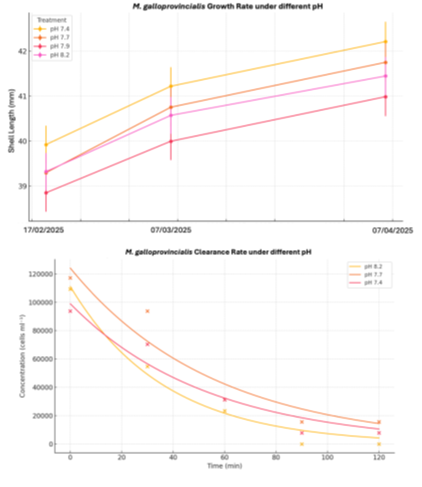COUPLED BIOMETRIC AND PHYSIOLOGICAL INDICATORS REVEAL THE IMPACTS OF CLIMATE CHANGE–DRIVEN ACIDIFICATION ON THE MEDITERRANEAN MUSSEL Mytilis galloprovincialis
Introduction
Human activities have already caused a decrease in the pH of the oceans by approximately 0.1 units, with an average decline of about 0.02 units per decade (Doney et al., 2009). The North Adriatic basin experiences acidification rates that exceed global averages due to river input which intensifies pH fluctuations (Cantoni et al., 2024). Mytilus galloprovincialis, a dominant species in coastal areas responsible for over 60 percent of Italian mussel production, plays a crucial role in the ecosystem through water filtration, nutrient removal, and habitat creation. However, the biomineralization of its shel depends on carbonate saturation and is highly sensitive to decreases in pH (Waldbusser et al., 2015). Reductions in pH can impair linear growth, weight gain, and filtration rate (Bressan et al., 2014). These combined sub-lethal effects undermine the o fitness and commercial value of mussels, making the northern Adriatic a critical area for evaluating the vulnerability of calcifying organisms. Integrated analyses of biometric, and physiologica l parameters help to address existing gaps in understanding the species’ adaptability. The understanding the resilience thresholds of M. galloprovincialis is vital for supporting adaptive management strategies in the climate scenarios projected for the 21st century.
Material and Methods
Juvenile Medietrranean mussel (Mytilus galloprovincialis) were collected from the North Adriatic Sea, cleaned, and acclimated for one week at 24 °C, salinity 27 ‰ and pH 8.2. After tagging and removal of byssal threads, mussels were distributed by weight into 12 × 70 L aquaria (≈ 25 individuals each). Four pH were imposed—ambient (8.2) plus three acidified levels (7.9, 7.7, and 7.4)—with CO₂ bubbling used to reach and maintain target values; each treatment had three replicate tanks. All systems were mechanically and UV-filtered continuously aerated and fed daily with a mixed-algal ration equal to 5–6 % of mussel wet mass. The experiment ran for 90 days, a period expected to allow roughly 1 cm of shell growth to the commercial size of ~4 cm. Temperature, salinity, dissolved oxygen, and pH were monitored daily; total alkalinity was measured weekly thereafter to calculate pCO₂, and full carbonate chemistry. Mortality was recorded daily. At day 0, day 45, and day 90, subsamples of ten mussels per treatment were analyzed for shell length, thickness, total wet and dry mass, meat yield, condition index, hepatopancreas mass, and specific growth rate. The clearance rate was quantified at the beginning and end of the trial on three mussels per treatment by tracking the exponential decline of algal cells in 1 L beaker over 2 h, with samples taken every 30 min for microscopic counts.
Results
At the onset of the experiment shell length did not differ among pH treatments (8.2, 7.9, 7.7, and 7.4). A one-way ANOVA on 250 tagged mussels (n = 62–63 per pH) yielded F₃, 246 = 1.08, p = 0.36, confirming homogeneity of baseline size. Mean length increased steadily at all pH levels. Linear mixed-effects modeling with a random intercept for each individual detected a strong main effect of Time (p < 0.001) but neither a main effect of pH (p ≥ 0.07) nor a pH × Time interaction (all interaction terms p > 0.10). Growth therefore followed parallel trajectories irrespective of carbonate chemistry. M ussels elongated by 2.1–2.5 mm, equivalent to 0.043–0.051 mm day⁻¹. Shorter windows showed slightly faster daily rates during the first 18 days (0.07 mm day⁻¹) than during the subsequent days (0.05 mm day⁻¹), but the pattern was consistent across treatments. The data suggest a trend toward faster clearance at the optimal. pH Single-vessel time-courses of algal concentration fitted well to first-order exponential decay. The derived rate constants (k) translated to volumetric clearance rates of 0.28 ml min⁻¹ (16.8 ml h⁻¹) at pH 7.7, 0.27 ml min⁻¹ (16.1 ml h⁻¹) at pH 7.4, and 0.41 ml min⁻¹ (24.5 ml h⁻¹) at pH 8.2.
Discussion
Over seven weeks, the animals grew at identical rates (~0.05 mm day⁻¹, ≈ 2.3 mm total) across seawater pH 8.2–7.4, indicating short-term shell-length growth is insensitive acidification. Yet feeding assays revealed a ~35 % drop in clearance rate below ambient pH, suggesting energy acquisition is already compromised. This divergence implies mussels can initially maintain shell extension by reallocating resources, but longer or multi-stress exposures may reveal hidden costs. Thus, while early growth appears resilient to near-future ocean acidification, reduced feeding efficiency emerges as an early warning signal.
Bibliography
Bressan, M., Chinellato, A., Munari, M., Matozzo, V., Manci, A., Marčeta, T., Finos, L., Moro, I., Pastore, P., Badocco, D., & Marin, M. G. (2014). Does seawater acidification affect survival, growth and shell integrity in bivalve juveniles? Marine Environmental Research, 99, 136–148. https://doi.org/10.1016/j.marenvres.2014.04.009
Cantoni, C., De Vittor, C., Faganeli, J., Giani, M., Kovač, N., Malej, A., Ogrinc, N., Tamše, S., & Turk, V. (2024). Carbonate system and acidification of the Adriatic Sea. Marine Chemistry, 267, 104462. https://doi.org/10.1016/j.marchem.2024.104462
Doney, S. C., Fabry, V. J., Feely, R. A., Kleypas, J. A., & Annual Reviews. (2009). Ocean acidification: the other CO2 problem. Annu. Rev. Mar. Sci., 169–192. https://doi.org/10.1146/annurev.marine.010908.163834
Waldbusser, G. G., Hales, B., Langdon, C. J., Haley, B. A., Schrader, P., Brunner, E. L., Gray, M. W., Miller, C. A., Gimenez, I., & Hutchinson, G. (2015). Ocean acidification has multiple modes of action on bivalve larvae. PLoS ONE, 10(6), e0128376. https://doi.org/10.1371/journal.pone.0128376
